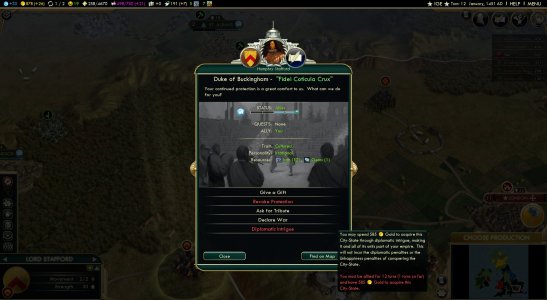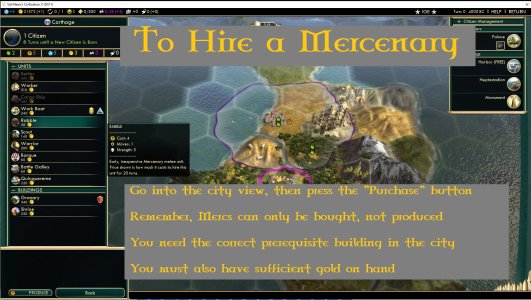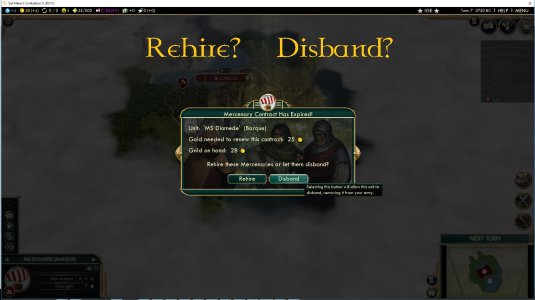Hey,
@jeriko one - welcome. Am hoping you can help us keep things right, historically, especially on the eastern half of the map - since you're the expert in this area.
Will Thrace, Gaul, and Celtiberia be considered confederation tribes
I expect Thrace to be playable, but Gaul and Celtiberia will most likely be city states, although with perhaps more than 1 city in that empire. You could make an argument for 2-3 seperate city states for each of those entities, but I think that's probably
too accurate for the purposes of the scenario. In game terms, I'm not sure I'd want to drill down on the confederation issue, especially with Rome. Civ5 is rather a crude at running scenarios, as most of what you need (short-term focus, existential struggle) simply isn't what the game engine was designed to provide. It takes a lot of twisting to get it to even look like it can run a decent scenario. Trying to recreate the complexities of intra-Roman political realities is probably beyond our reach here - especially since that would mean a lot of work occurring in 50-100 tiles of the map that only directly involve 1 civ.
Should the Getae be in the game? Those parts of the map will be very desolate.
@Mantis Toboggan M.D. and I had a discussion earlier about the "usefulness" of Barbarians in the scenario or not. I thought that on the edges of the maps, a few Barb camps might prove interesting, although he thought the Barbs just not historically applicable. If I'm adding the Numidians/Lybians as city states to the southern map edges to take the place of the Barbs, I suppose treating the northern edge the same way would be appropriate. Can always add Getae to the list.
Begs the question, though: I'm not 100% certain you can give UU's to city states. I tried this once and it didn't work, using the game's "normal" method of assigning UU's. There's a "back door" way of doing it, but basically removing all units from city states, then using the Scenario Management Engine (SME) to spawn units periodically and control the type of unit that appears. It just doesn't seem proper that Numidia would use the same looking units as Getae, especially when we have some really good models of Numidia/Lybia to work with. I guess the bottom line is, we will use city states on the map edges to take the place of barbs, and those city states will have a form of UUs, even if I have to beat the game engine with a hammer to get it done...

a city-state might be needed in Southern Anatolia.
If we add Attaleia, it will be towards the end of the map design effort - if there's enough of a "blank space" on the map. I can definitely see that happening, but it ultimately depends on how many cities I actually place on the map. That decision is a relative one, as once we finalize the actually playables and most of the city states, we'll need to determine some kind of relative populations between all the civs. I'm not saying that we need a formula that says "1 city population for each 100,000 people in the empire" and divide it up like that, but a reasonable heuristic along those lines would definitely be helpful.
I'd also make the argument that the capitals are much larger than the "provincial" cities, to demonstrate their relative concentration of the centers of power in an empire - more so than actual population numbers. So, for example: Rome has a million people living there and Taranto has 500,00 - if I assign a population of 10 to Rome, I wouldn't necessarily assign Taranto as 5. Perhaps 3? And other cities might be smaller in population but more important strategically (Syracuse?) - it would get a larger population on the city on the map, simply to demonstrate that importance.
This ultimately comes down to "balance" between the civs. I plan to approach this problem by saying that Rome represents 100% of its population as the baseline. So, then Carthage might be 90% of that number. Perhaps the Ptolemies are 50%, and so on. We don't necessarily need a census of each civ, but coming up with a fair coefficient number (a percentage of Rome's 100%) for all the playables, is a good first start.
Once the playables are decided, we'd use a similar process for the city states, although I'd expect those numbers would be quite low by comparison. We'd also want to take into account the numbers of likely allies for each side. When the map is finished, the population (as represented in population points in all a civ's cities) "more or less" for both major protagonists would be similar, even if the total headcount of population might not be.
Depending on the frontiers of Gaul, Massilia, and Celtiberia
Those areas will be part of the extended city states of Gaul and Hispania. There will be nearby cities, but they will be quite small. Although they'll be easily conquered if a playable civ wanted to, the SME will add many "revolt events" to these cities so they revert back to original owners if not properly garrisoned.
In fact, revolts and changing alliances will be a common occurrence in the SME's event manager. In some cases, they'll be preventable by player actions, in other cases, not. We'll get to game and player events after the map is done and all of the units are added. It's inherently tied to the game's diplomacy system, so when we're working on setting up the relationships between all the playables and all the city states, we'll start designing the event structure then.
Should Epirus be renamed the “Epirote League”?
My intent on this scenario is to use a plain-vanilla English as much as I can. From what I recall from history, Epirus is a city I remember. Epirote League is more obscure, less engaging. I don't feel terribly strong about this, but I would like when a player opens the map, to recognize what they see. I'd expect anyone playing the mod would have at least a modicum of interest in the history of the time, but I wouldn't expect them to be experts. So, I'd recommend keeping things simple, but not if it breaks something historically.
Who should lead Rome? Carthage?
Rome: These two were replaced by a dictator in the aftermath of the Battle of Lake Trasimene.
This begs the question I've faced in other scenarios where leadership dramatically changed during the course of the historical time-frame of the scenario. Since changing the leader in game is basically impossible (it's not really, but it's damned painful to do so, with lots of externalities involved), then what is the right approach to select a leader: historical (who was in charge on day 1 of the war)? Most impact (who was the key figure during the entire time-frame? Scipio for Rome, Hannibal for Carthage? A combination between the two? Is dominating on the battlefield the same as running the civ bureaucracy back in the capital?
Rome is probably the hardest, but I'm wondering if we can find some kind of "father figure" to serve as the figure head of the civ for the entire scenario. We plan on adding a special kind of GG that is actually a unit with great power, abilities, promotions, etc. These will be the "guys in the field running things" - so Scipio becomes one of these "Magnates" (for the lack of a better term) who appear from time-to-time, bulldozing across the map, but not really running the day-to-day government back at HQ in Rome.
Perhaps Gaius Flaminius and Geminus Gnaeus Servilius would be such Magnates? Other candidates (ala Wiki): Fabius Cunctator, Publius Cornelius Scipio, Hasdrubal Barca, Mago Barca, etc.
I envision 2-4 of the Magnates available to either side (and possible to a few other playables) at any given time. They will be awarded by a player event, but the primary way to eliminate them is to gather a lot of combat power and go after them to kill the unit. There will also be a player event to remove a Magnate, if they've been on the map for say, "X" turns, and/or they've performed poorly on the fields. More to follow on that when we get to "events."
BTW: we could also use about 50 GG/GA names for R&C, and perhaps 25 or so for the other playables (they can come from before/after the 200-218 BC time frame). Can also add GG names for city states if we have any.
*********************************************************************************
I sincerely appreciate the effort on researching leaders of the civs - even the city states. Having names is important, as I'm planning on using a replacement UI for the city state popup that looks like this:

So, having a civ and leader name, maybe a motto, civ icons, etc., will all be used to populate this new popup. Usually, city states don't need this, but we will use these data for this scenario.
Am taking off in a few - business trip for a couple of days, so no modding time, unfortunately. Am hoping to return to work on this later in the week. Good ideas - keep 'em coming!
EDIT: I'm using Post #3 to keep a "current" version of the civs/city states list. I'll keep it updated as we gather more data. I'll eventually add information about UA's, UB's, UU's, etc., there as well.
Post #4 will be the one where we describe the design for the various Unit Packs, both the standard pack, and then any custom-civ variants.

 Depending on the frontier between the Seleucids and the Ptolemaic Egypt, a city-state might be needed in Southern Anatolia. It could be Attaleia controlled by the Pamphylians. However, we need to establish the borders first.
Depending on the frontier between the Seleucids and the Ptolemaic Egypt, a city-state might be needed in Southern Anatolia. It could be Attaleia controlled by the Pamphylians. However, we need to establish the borders first.

 Also congrats regarding the hotfixes to WAW!! If I can find the time I will surely take a look at it.
Also congrats regarding the hotfixes to WAW!! If I can find the time I will surely take a look at it. But, when working on a mod "family," often a small change in one will require a change in many of the other 3. Often, this will require a bit of testing, which finds another issue, then we get to repeat the cycle. I found myself working several hours yesterday working on about 20 "ankle biter" level of issues (a typo here, an incorrect but practically invisible to players model definition there, etc.), most of which didn't directly impact the mod, game or players, but I've found in the past that in Civ5 modding, you'll often see a bug/crash in a mod, then isolate where the mod crashed, check the code and see no errors in the code at all. This almost always means there's a small problem in the code which could be in a completely different part of the mod, but it manifests itself in a crash somewhere else. Makes debugging quite a challenge... So... I try to remove these little inconsistencies wherever I find them, so they don't have a chance to cause crashes elsewhere in the mod later on.
But, when working on a mod "family," often a small change in one will require a change in many of the other 3. Often, this will require a bit of testing, which finds another issue, then we get to repeat the cycle. I found myself working several hours yesterday working on about 20 "ankle biter" level of issues (a typo here, an incorrect but practically invisible to players model definition there, etc.), most of which didn't directly impact the mod, game or players, but I've found in the past that in Civ5 modding, you'll often see a bug/crash in a mod, then isolate where the mod crashed, check the code and see no errors in the code at all. This almost always means there's a small problem in the code which could be in a completely different part of the mod, but it manifests itself in a crash somewhere else. Makes debugging quite a challenge... So... I try to remove these little inconsistencies wherever I find them, so they don't have a chance to cause crashes elsewhere in the mod later on. This is humorous to me, as the SME running the Second Punic War (PW2) will be quite similar to the streamlined SME running the "WAW WW2 Scenario On Any Map" mod. It will be simpler in some ways, but more complicated in others - especially since mercenaries (Mercs) played such a large role in ancient warfare in the Med.
This is humorous to me, as the SME running the Second Punic War (PW2) will be quite similar to the streamlined SME running the "WAW WW2 Scenario On Any Map" mod. It will be simpler in some ways, but more complicated in others - especially since mercenaries (Mercs) played such a large role in ancient warfare in the Med.
